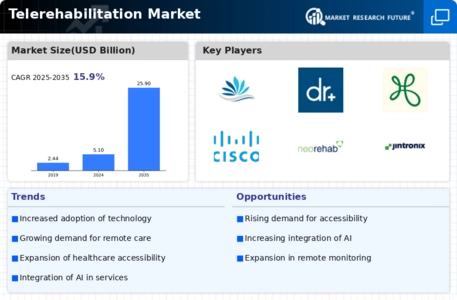Market Trends
Key Emerging Trends in the Telerehabilitation Market
The Telerehabilitation Market has come to be the focus of strategizing on the part of companies, as they struggle to stay or come number through various strategies, in the ever-changing healthcare arena. A key strategy would be the constant development of new systems and platforms that would offer telerehabilitation. With rising demand of remote healthcare services, companies push a lot on research and development to invent unique and friendly to the user tele rehabilitation products. According to these solutions patients’ engagement would be increased, rehabilitation exercises become more effective, and the monitoring will be conducted in real-time. The innovators of these products would carve out their share of the market for themselves and keep other receivers of services in competition by tackling the broadly based issues in a healthcare provision sector via providing access to rehabilitation services for patients, their families, and patients’ caregivers.
To mention, strategic joint ventures and collaborations play a critical role in the shaping of market share among the Telerehabilitation Market. With the heterogeneity of rehabilitation treatment services and also entirely solutions required, there are collaborations happening between firms and healthcare centers, rehabilitation centers and technology partners. This co-operation allows for the establishment of telerehabilitation services within the already existing healthcare systems and enables smooth, comprehensive care for patients and, of course, helps to extend the market reach of the services. Through harnessing team talents, businesses firmly put themselves at the forefront, providing a high-end range of telerehabilitation, featuring solutions across the entire healthcare area and catering to the needs of physicians and patients from multiple clinical subspecialties.
Pricing models and reimbursements policies are an important perspective when market share positioning in regard to tele-rehabilitation Market comes into the picture. Organizations develop their health reimbursement buying criteria, knowing the quality of the contents of their telerehabilitation product, the add-on features, and the cost per provider. Through the development of several ferreanced-platforms at competitive prices some companies stress with the improving of the clinical outcomes and client satisfaction. others rent out subscriptions or tiers to cater to a wider customer base. An ideal strategic vision for this engagement should balance affordability with a value perceived by institutions to ensure obtaining significant market shares for the company and hospital concerns about costs.
To grow market share in that industry, the success of such strategies in the marketing and distribution aspects is primarily important. Businesses focus attention on building strong marketing campaigns which are designed to bring telerehabilitation platforms to the knowledge of the stakeholders (such as healthcare professionals, rehabilitation specialists, and patients). Brand perception is promoted with the creation of cognizant promotional avenues that build an image of trustworthiness, integrity and other core values. Along with that, the use of distribution channels has helped to optimize these solutions so that they can spread out and reach different healthcare areas such as rehabilitation clinics, hospitals, and individual practitioners, just among others. Partnerships with telecommunication providers and healthcare networks will lead to enhanced market share position favorably attracting broader consumer market while providing a wide range of telerehabilitation services.

















Leave a Comment